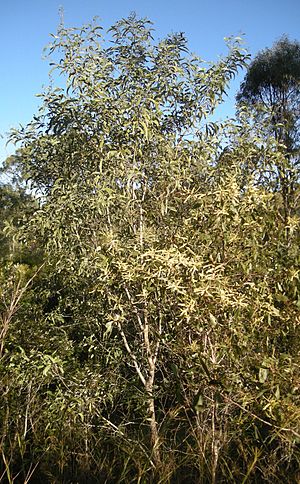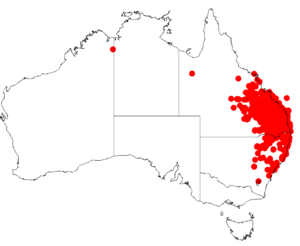Early-flowering black wattle facts for kids
Quick facts for kids Early-flowering black wattle |
|
|---|---|
 |
|
| Scientific classification | |
| Genus: |
Acacia
|
| Species: |
leiocalyx
|
 |
|
| Occurrence data from AVH | |
Acacia leiocalyx is a type of wattle tree. It is also known by common names like black wattle, early flowering black wattle, lamb's tail wattle, and curracabah. This tree grows in Queensland, Australia, and can be found as far south as Sydney.
You'll often see Acacia leiocalyx in eucalypt woodlands. It prefers soil that drains well and isn't too deep. This tree doesn't live very long. It usually grows to be about 6 to 7 metres (20–23 feet) tall. Its trunk can be around 180 millimetres (7 inches) wide.
What it Looks Like
This small Acacia tree has bark with grooves or furrows. Its green leaves are shaped like sickles, which are curved blades. These leaves have clear veins, and the two bottom veins join together near the base of the leaf.
The flowers are yellow and grow in thin spikes. After flowering, the tree produces narrow, somewhat curly seed pods. These pods usually hang in loose groups. Acacia leiocalyx typically blooms from June to October.
Family and Related Species
Scientists used to group several similar trees under the name Acacia cunninghamii. Now, they know these are actually different species. The trees in the Acacia cunninghamii group all have spiky flowers and large, flattened leaf stems called phyllodes. They are very closely related, which can make them hard to tell apart.
A. leiocalyx is most similar to Acacia concurrens. However, there are small differences between them. A. leiocalyx has smooth, sharply angled small branches that are usually reddish-brown. Its leaf stalk base (called a pulvinus) is short and red. The outer part of its flower (called the calyx) is smooth or has almost no hairs.
On the other hand, A. concurrens has thicker, angled branches that are scaly and usually not reddish. Its pulvinus is long and grey-green. Its calyces have a few stiff, short hairs near their base. Sometimes, you might find trees that are a mix of these two species, especially in northern New South Wales. Acacia crassa is another related species.
Scientists recognize two types, or subspecies, of Acacia leiocalyx:
- Acacia leiocalyx (Domin) Pedley subsp. leiocalyx
- Acacia leiocalyx subsp. herveyensis Pedley
Where it Grows
This tree comes in many different forms. It is found all over Queensland, from the coast to more than 325 kilometres (200 miles) inland. It often grows in rocky or gravelly soil.
Animals sometimes eat Acacia leiocalyx when other food is scarce. However, it's not a main food source for animals during dry periods or droughts.
Uses
The wood from Acacia leiocalyx is colorful. However, it can split easily, even if the ends are sealed.
Some people say that the seeds and gum from this tree can be eaten. But it's important to be careful. There are many similar species that are hard to identify, and some might not be safe to eat.
Images for kids



